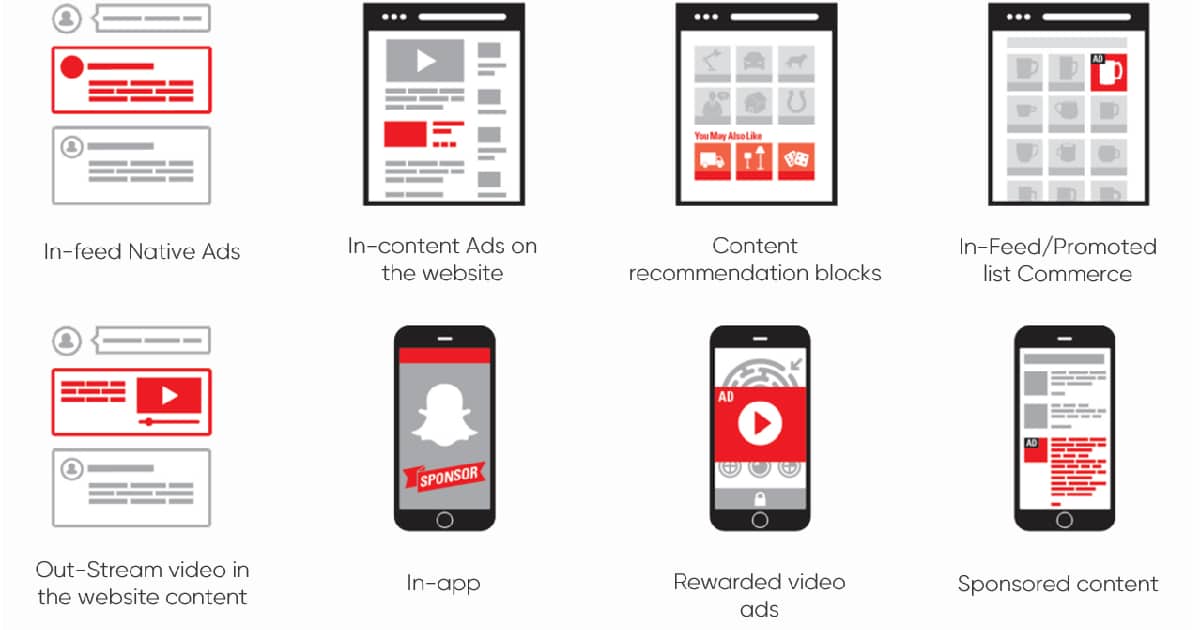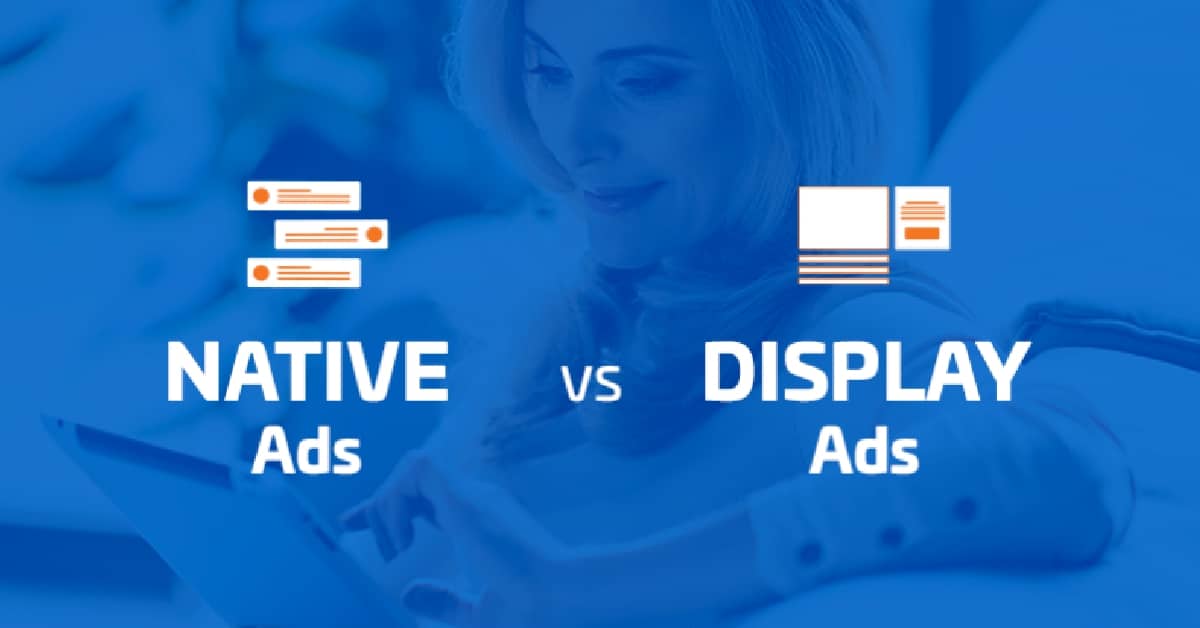Advertising has become an integral part of the marketing landscape. Businesses across various industries are leveraging the power of digital advertising to reach their target audiences and drive desired outcomes. Among the different types of digital advertising, display advertising and native advertising are two popular approaches that marketers employ to capture consumer attention and promote their products or services. Understanding the difference between these two strategies is essential for crafting effective advertising campaigns.
Overview of Display Advertising

Display advertising refers to the practice of using visual elements, such as images, banners, and videos, to promote products or services on websites, mobile apps, or social media platforms. Its main characteristics include:
- Visual Impact: Display ads leverage eye-catching visuals to capture users’ attention and create brand awareness.
- Broad Reach: These ads can be displayed on various websites and platforms, allowing businesses to reach a large audience.
- Targeting Capabilities: Display advertising offers advanced targeting options, enabling marketers to deliver ads to specific demographics, interests, or behaviors.
In the world of display advertising, marketers can choose from different formats to convey their messages effectively:
- Banners: These are rectangular advertisements that typically appear at the top, bottom, or sides of a webpage.
- Pop-ups: Pop-up ads appear in a separate window or tab, usually triggered by user actions or as timed intervals.
- Video Ads: These ads play short videos to deliver engaging content and capture users’ attention.
Advantages of Display Advertising:
Display advertising offers several advantages that make it a valuable strategy for marketers:
- Wide reach and visibility: Display ads can be placed on various websites and platforms, allowing businesses to reach a large audience and increase brand visibility.
- Potential for high brand exposure: With visually appealing designs and strategic ad placement, display ads have the potential to generate significant brand exposure and recognition among target audiences.
- Targeting options for precise audience segmentation: Display advertising platforms provide advanced targeting capabilities, allowing marketers to deliver ads to specific demographics, interests, or behaviors. This precise audience segmentation helps increase the relevance and effectiveness of the ads.
Limitations of Display Advertising:
While display advertising offers numerous benefits, it also has some limitations to consider:
- Banner blindness: Users may develop banner blindness, where they ignore or overlook display ads due to their prevalence and repetitive nature. This can reduce the effectiveness of the ads and hinder their impact.
- Ad blockers: The use of ad-blocking software has increased in recent years, impacting the visibility of display ads. Ad blockers prevent ads from being displayed, limiting their reach and effectiveness.
- Limited engagement: Display ads generally lack interactivity compared to other formats like interactive videos or rich media ads. This can result in limited user engagement and lower click-through rates (CTRs) for display ads.
Illustrating the Effectiveness of Display Advertising:
To showcase the effectiveness of display advertising, consider the following statistic:
According to a study by eMarketer, global spending on display advertising is projected to reach $226 billion by 2025. This growth indicates the continued popularity and effectiveness of display advertising as a marketing strategy.
Understanding the benefits and limitations of display advertising provides a solid foundation for exploring an alternative approach—native advertising.
Overview of Native Advertising

Native advertising refers to a form of advertising that seamlessly blends into the user experience of a website or platform, appearing as natural and integrated content rather than traditional advertisements. Its main characteristics include:
1. Integration with Content: Native ads are designed to match the form and function of the platform on which they are displayed, making them indistinguishable from the surrounding content. They adopt the same visual style, format, and language, allowing them to seamlessly blend in.
2. Contextual Relevance: Native ads are highly targeted and tailored to the interests and preferences of the target audience. They provide value by delivering relevant and informative content that aligns with the platform’s overall theme or topic.
3. Non-Disruptive Approach: Unlike traditional display ads, which often interrupt the user experience, native ads aim to provide a non-intrusive and seamless advertising experience. They avoid being disruptive or obtrusive to users while still delivering the brand message effectively.
Native ads seamlessly blend into the user experience by leveraging the design elements and formatting of the platform. They can appear as various types of content, including:
1. Sponsored Content: Native ads in the form of sponsored articles, videos, or other media that are created by advertisers but presented in a way that aligns with the platform’s editorial content.
2. Advertorials: These are advertisements designed to resemble editorial content. Advertorials provide useful information while subtly promoting a product or service.
3. In-Feed Ads: In-feed ads appear within the natural content feed of a platform, such as social media feeds or news article lists. They are integrated seamlessly with the other content and often labeled as sponsored.
Benefits and Challenges of Native Advertising
Benefits:
- Higher User Engagement: Native ads have been reported to achieve higher viewability, engagement rates, and click-through rates (CTR) compared to traditional display ads. They provide a more relevant and personalized experience, capturing the user’s attention effectively.
- Improved Brand Perception: Native ads help build a positive brand image by associating the brand with valuable and informative content. They create a seamless connection between the brand and the user’s interests, improving brand perception.
- Enhanced User Experience: Native ads contribute to a better user experience as they blend seamlessly with the surrounding content, avoiding disruption and enhancing the overall browsing experience.
Challenges:
- Transparency and Disclosure: Maintaining transparency is crucial in native advertising to ensure users are aware they are consuming sponsored content. Proper disclosure of the commercial nature of native ads is essential to maintain user trust.
- Content Quality and Ethics: Native ads should provide genuine value to users and adhere to ethical standards. The content should align with the platform’s quality and maintain a balance between promotional messaging and informative or entertaining content.
- Integration Complexity: Designing and implementing native ads that seamlessly integrate with different platforms can be technically challenging. Advertisers need to adapt their creatives to fit the specific requirements and design principles of each platform.
Comparison of Display and Native Advertising
Display advertising and native advertising are two distinct approaches to online advertising, each with its own characteristics and advantages. Here is a comparison highlighting the key differences between display and native advertising:
1. Format and Appearance:
Display Advertising: Display ads are designed to stand out and are typically presented as banners or other graphical elements. They often use eye-catching visuals, bold colors, and distinctive branding to attract attention. Display ads aim to grab the user’s focus and may appear in various sizes and formats across websites.
Native Advertising: Native ads are created to seamlessly blend into the content and design of the platform where they are displayed. They match the look, feel, and style of the surrounding content, making them appear more organic and less like traditional advertisements. Native ads can take the form of sponsored articles, videos, or other content types that mimic the platform’s editorial style.
2. User Experience:
Display Advertising: Display ads are more conspicuous and can sometimes disrupt the user experience. They may interrupt the flow of content, leading to ad blindness or ad avoidance as users become accustomed to ignoring them.
Native Advertising: Native ads provide a non-disruptive user experience by fitting seamlessly into the platform’s content. They are less likely to be perceived as intrusive, as they blend in with the natural flow of the website or app. Native ads aim to deliver value and engage users without disrupting their browsing experience.
3. Targeting and Personalization:
Display Advertising: Display ads can utilize a variety of targeting options, such as demographic data, user interests, and browsing behavior. However, their targeting capabilities may not be as refined as native ads, resulting in a broader reach that may include less relevant audiences.
Native Advertising: Native ads often leverage sophisticated targeting capabilities. They can utilize contextual targeting, user data, and AI-driven algorithms to deliver highly personalized content to the intended audience. This level of targeting allows native ads to reach users who are more likely to be interested in the content and thus achieve higher engagement.
4. Effectiveness and Engagement:
Display Advertising: Display ads are generally effective in generating brand awareness, particularly when they are strategically placed on high-traffic websites. However, their effectiveness can vary depending on the ad design, placement, and targeting. Display ads typically have lower click-through rates (CTR) compared to native ads.
Native Advertising: Native ads have been shown to achieve higher engagement rates, longer time spent on content, and higher CTRs compared to display ads. Due to their seamless integration with the platform’s content, native ads can capture users’ attention and provide a more relevant and engaging experience.
5. Cost and ROI:
Display Advertising: Display ads often have lower initial costs compared to native ads, particularly for programmatic display advertising. However, the effectiveness and ROI of display ads can vary depending on factors such as ad quality, placement, targeting, and competition for ad space.
Native Advertising: Native ads tend to have higher initial costs compared to display ads. Since they require customized content creation and integration with the platform, native ads can involve higher production expenses. However, the higher engagement and click-through rates of native ads can potentially lead to a better return on investment, especially when targeting specific audiences and delivering valuable content.
It’s important to note that the effectiveness of both display and native advertising can vary depending on the campaign objectives, industry, target audience, and other factors. Advertisers should carefully consider their goals and audience preferences when choosing between display and native advertising approaches.
Best Practices for Choosing Between Display and Native Advertising
When it comes to choosing between display advertising and native advertising, it’s important to consider various factors to ensure the best fit for your marketing goals. Here are some best practices to help you make an informed decision:
1. Define Your Marketing Goals:
Clearly articulate your marketing objectives before choosing an advertising method. Are you aiming for brand awareness, lead generation, conversions, or engagement? Different goals may require different approaches, so aligning your objectives will guide your decision-making process.
2. Understand Your Target Audience:
Consider your target audience’s preferences, behavior, and demographics. Are they more receptive to visually striking display ads or content-driven native ads? Understanding your audience’s preferences will help you select the format that resonates best with them and delivers the desired results.
3. Evaluate Campaign Objectives:
Assess the specific goals and requirements of your campaign. If your objective is to drive immediate conversions or clicks, display advertising may be suitable due to its visually prominent nature. On the other hand, if your focus is on building brand trust, engaging with the audience, or delivering valuable content, native advertising may be a better choice.
4. Consider Budget Allocation:
Evaluate your budget and determine how much you can allocate to each advertising method. Display ads often have lower initial costs, making them a cost-effective option for broader reach. Native ads may require higher production costs but can provide better engagement and ROI. Consider your budget limitations and weigh them against your campaign goals.
5. Test and Iterate:
Start with small-scale tests to evaluate the performance of both display and native advertising. Compare the results, such as click-through rates, engagement metrics, conversions, and cost-effectiveness. Use A/B testing to experiment with different ad creatives, placements, and targeting strategies to optimize your campaigns.
6. Track and Measure Performance:
Implement robust tracking and analytics tools to monitor the performance of your campaigns. Measure key metrics such as impressions, clicks, conversions, engagement rates, and return on ad spend (ROAS). This data will provide insights into the effectiveness of each advertising method and guide future optimization efforts.
7. Optimize and Refine:
Continuously analyze the performance data and make data-driven optimizations. Adjust targeting parameters, ad creatives, messaging, and placements based on the insights gained. Optimize for conversions, engagement, or any other relevant metric based on your campaign objectives.
8. Leverage Synergies:
Consider using both display and native advertising in a complementary manner. For example, use display ads to create initial awareness and reach a broader audience, and then follow up with native ads to engage and nurture leads. By leveraging the strengths of both methods, you can create a holistic advertising strategy.
Choosing between display advertising and native advertising requires careful consideration of your marketing goals, target audience, campaign objectives, and budget. Understanding the differences and strengths of each method is crucial for making an informed decision. By aligning your goals, audience preferences, and campaign objectives, you can select the most suitable approach and maximize the effectiveness of your advertising efforts. Regular performance tracking, optimization, and leveraging synergies will help you achieve the desired results and drive success in your advertising campaigns.
FAQs
The primary difference between display and native advertising lies in their appearance and integration with the surrounding content. Display ads are designed to stand out and typically look like banners or graphics that contrast the website they appear on. Native ads, on the other hand, are designed to blend in seamlessly with a website’s content, matching its look and feel.
Display ads often interrupt the user’s browsing experience as they are visually distinct from the website’s content. They may be perceived as more intrusive. Native ads, on the other hand, provide a more organic and non-disruptive user experience since they blend in with the surrounding content. Native ads aim to provide value and relevance to the user, enhancing their overall experience.
Both display and native advertising offer robust targeting capabilities, but they differ in their approach. Display ads typically rely on demographic and contextual targeting, allowing advertisers to target specific audience segments or show ads on websites related to their product or service. Native ads, in addition to demographic and contextual targeting, also leverage behavioral targeting and user intent signals to deliver more personalized and relevant content to the user.
The effectiveness of display and native ads depends on various factors such as campaign goals, target audience, and the context in which they are used. Studies have shown that native ads often have higher viewability, engagement rates, and click-through rates (CTR) compared to display ads. However, display ads can still be effective for generating brand awareness and achieving broader reach. It’s important to consider your specific campaign objectives and audience preferences when determining which method is more suitable for your advertising goals.
Yes, display and native advertising can be used together in a marketing campaign to complement each other’s strengths. Display ads can be effective for creating initial awareness and reaching a broad audience, while native ads can be utilized to engage and nurture leads further down the funnel. By combining both methods strategically, advertisers can leverage the benefits of each to maximize the impact of their campaign.
When choosing between display and native advertising, consider factors such as your marketing goals, target audience preferences, campaign objectives, and budget allocation. Understand the differences in appearance, user experience, and targeting capabilities of both methods. Conduct tests and track performance metrics to evaluate their effectiveness. Ultimately, the decision should align with your specific campaign goals and cater to the preferences of your target audience.
Our Related Articles
- How To Choose The Right Digital Marketing Strategy For Your Business
- What Is OTT Advertising, And Why Is It A Trend?
- 9 Compelling Resons You Should Be Advertising Online
- 5 Simple Ways To Lower The Cost Of Your Facebook Ads
- 7 Types Of Ad Fraud And How To Prevent Ad Fraud?
- 8 Ways To Improve Online Marketing Strategy For Business Growth
- 9 Compelling Resons You Should Be Advertising Online
- 7 Online Advertising Benefits
- What Is Keyword Cannibalization And How Can You Fix It?
 Anas is our go-to copywriter with a knack for crafting persuasive and high-converting eCommerce landing pages. His passion for words and understanding of consumer psychology helps turn visitors into loyal customers. When he's not refining his copy, Anas enjoys exploring the latest digital marketing trends and experimenting with new writing techniques. His blend of creativity and strategic thinking makes him an indispensable part of our energetic team.
Anas is our go-to copywriter with a knack for crafting persuasive and high-converting eCommerce landing pages. His passion for words and understanding of consumer psychology helps turn visitors into loyal customers. When he's not refining his copy, Anas enjoys exploring the latest digital marketing trends and experimenting with new writing techniques. His blend of creativity and strategic thinking makes him an indispensable part of our energetic team.












